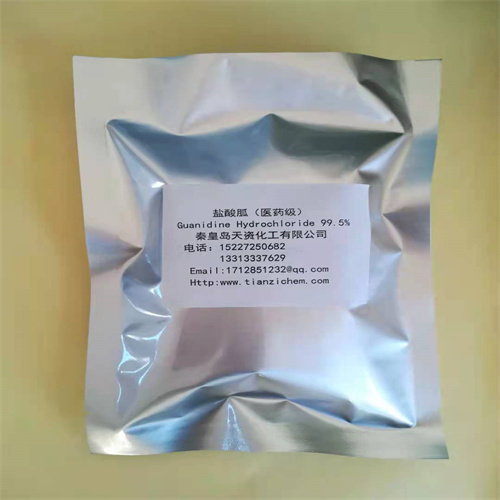
- English
- Español
- Português
- русский
- Français
- 日本語
- Deutsch
- tiếng Việt
- Italiano
- Nederlands
- ภาษาไทย
- Polski
- 한국어
- Svenska
- magyar
- Malay
- বাংলা ভাষার
- Dansk
- Suomi
- हिन्दी
- Pilipino
- Türkçe
- Gaeilge
- العربية
- Indonesia
- Norsk
- تمل
- český
- ελληνικά
- український
- Javanese
- فارسی
- தமிழ்
- తెలుగు
- नेपाली
- Burmese
- български
- ລາວ
- Latine
- Қазақша
- Euskal
- Azərbaycan
- Slovenský jazyk
- Македонски
- Lietuvos
- Eesti Keel
- Română
- Slovenski
- मराठी
- Srpski језик
How much do you know about guanidine hydrochloride?
2022-08-03
Guanidine hydrochloride is an organic substance with the chemical formula CH6ClN3, white or yellowish lumps. It is used as an intermediate for medicines, pesticides, dyes and other organic compounds. It is an important raw material for the manufacture of sulfonamides and folic acid. It can also be used as an antistatic agent for synthetic fibers.
1. Appearance: white or slightly yellow lumps
2. Melting point (℃): 181-183
3. Relative density (g/mL, 20/4℃): 1.354
4. Solubility: 228g can be dissolved in 100g of water at 20°C, 76g can be dissolved in 100g of methanol, and 24g can be dissolved in 100g of ethanol. Almost insoluble in acetone, benzene and ether.
5. pH value (4% aqueous solution, 25℃): 6.4
Guanidine Hydrochloride Uses:
1. It can be used as intermediates in medicine, pesticide, dye and other organic synthesis. It can be used to synthesize 2-aminopyrimidine, 2-amino-6-methylpyrimidine, 2-amino-4,6-dimethylpyrimidine, and is used for the manufacture of sulfadiazine, sulfamethazine, sulfamethazine and other sulfa drugs. Intermediate.
2. Guanidine hydrochloride (or guanidine nitrate) reacts with ethyl cyanoacetate to form 2,4-diamino-6-hydroxypyrimidine, which is used to synthesize the anti-anemia drug folic acid. It can also be used as an antistatic agent for synthetic fibers.
3. It can also be used as a protein denaturant.
 resolve resolution:
resolve resolution:
Using dicyandiamide and ammonium salt (ammonium chloride) as raw materials, the melting reaction is carried out at 170-230 ℃ to obtain crude guanidine hydrochloride, which is refined to obtain the finished product.
Security Information:
Dangerous Goods Sign: Harmful
Safety sign: S22
Hazard identification: R22R36/38
1. Appearance: white or slightly yellow lumps
2. Melting point (℃): 181-183
3. Relative density (g/mL, 20/4℃): 1.354
4. Solubility: 228g can be dissolved in 100g of water at 20°C, 76g can be dissolved in 100g of methanol, and 24g can be dissolved in 100g of ethanol. Almost insoluble in acetone, benzene and ether.
5. pH value (4% aqueous solution, 25℃): 6.4
Guanidine Hydrochloride Uses:
1. It can be used as intermediates in medicine, pesticide, dye and other organic synthesis. It can be used to synthesize 2-aminopyrimidine, 2-amino-6-methylpyrimidine, 2-amino-4,6-dimethylpyrimidine, and is used for the manufacture of sulfadiazine, sulfamethazine, sulfamethazine and other sulfa drugs. Intermediate.
2. Guanidine hydrochloride (or guanidine nitrate) reacts with ethyl cyanoacetate to form 2,4-diamino-6-hydroxypyrimidine, which is used to synthesize the anti-anemia drug folic acid. It can also be used as an antistatic agent for synthetic fibers.
3. It can also be used as a protein denaturant.

Using dicyandiamide and ammonium salt (ammonium chloride) as raw materials, the melting reaction is carried out at 170-230 ℃ to obtain crude guanidine hydrochloride, which is refined to obtain the finished product.
Security Information:
Dangerous Goods Sign: Harmful
Safety sign: S22
Hazard identification: R22R36/38




